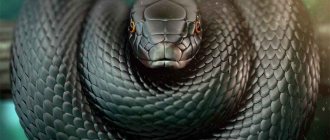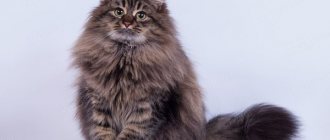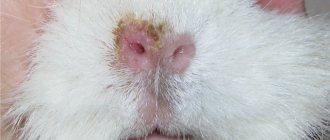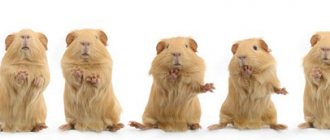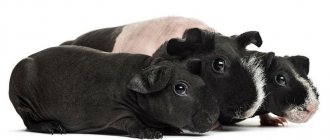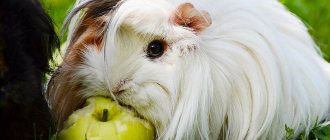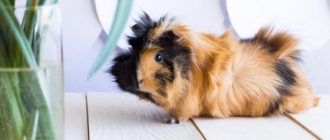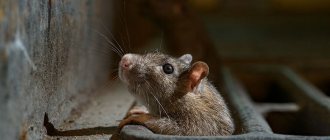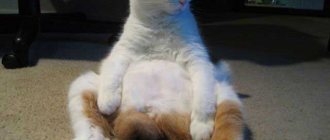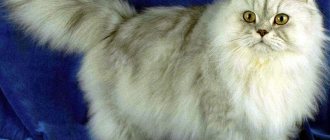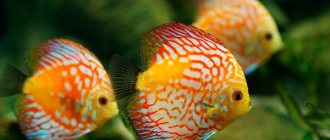American
The American guinea pig is a well-known breed that is the most widespread and most unpretentious; it is also sometimes called the English one. It has short, straight fur of various colors with a glossy sheen. The color of the eyes, which are quite large in size, can also be very different, and often matches the coat. This fur feels silky and smooth to the touch. Among the colors of her fur there are even lilac and red.
Her wide nose is slightly crooked. It is of average size among the species, loves to play with toys, and is active. It is better to keep these animals in pairs, as they live longer.
Important! Falling from a height is dangerous for pigs.
Even if an animal falls from a low surface, this can be fatal for it.
Smooth fur and smooth skin
Baldwin guinea pigs are completely hairless and have smooth skin. Skinny has fur on his nose and paws, from birth to the end of his life. The main features of care are compliance with the temperature regime and a more varied diet (the diet should be higher in calories than that of other pigs). Read more about smooth guinea pigs in the article Baldwin Guinea Pig. Left - Skinny, right - Baldwin
The Self breed has English roots and dates back to the 1920s. These are representatives with short hair, a relatively compact build, and a color in which only one color predominates. Moreover, even the ears, eyes and paw pads must match the color of the coat. Cute selfies can be both calm and active.
Agouti is almost the ancestor of all guinea pigs. At the same time, there is a type of Agouti color that is characteristic of other breeds. The main feature of the color is ticking. At the base of the hair, almost at the skin, the hair has one color, in the middle it turns into a second color, the tips have a third shade, most often darker. Ticking is present everywhere, even on the paws. Agoutis are also highly trainable.
Crested
The American Crested is so called because of the rosettes on the top of its head that are colored white. They are also called crested guinea pigs. The animal itself has short, smooth fur, without any partings. Crested dogs do not have any pronounced character traits; they live well with almost any kind of piggyback, and they are also favorable towards humans.
Peruvian
This guinea pig is the longest-haired, its long hairs parted on the back make it look like a small woman's wig. According to standards officially registered in 1930, this ancient breed must have the following characteristics:
- thick hairs of a wide variety of colors can be up to 30-50 centimeters long;
- straight parting along the ridge;
- long bangs cover the entire muzzle of this pig;
- a pair of rosettes in the sacral area;
- a slight curl of fur on the nose, which then develops into “whiskers”.
But Peruvian guinea pigs have short fur on their legs and tummy.
On the paws between the toes, short hair is directed towards the body. We advise you to learn how to care for a guinea pig at home
Habitat and behavioral characteristics
The capybara is rightfully the largest guinea pig. These wild rodents are not very different in appearance from their smaller relatives; in addition to the blunt-nosed square structure of the muzzle, they have the following distinctive features:
- strong and massive physique;
- large head with widely spaced nostrils;
- small eyes;
- short rounded ears.
Often such individuals reach 1.5 meters in length, while at the withers their size is 1 meter. On average, the mass of a capybara is about 60 kilograms, although there are larger individuals; among the weight record holders there are those whose mass is approximately 100 kilograms. Capybaras behave rather clumsily and mundanely, the fact is that the hind legs are much shorter than the front. They have a hard coat that fits tightly to the pet's body. In the wild, there are gray and red individuals, their shade may vary.
This is what Capybara looks like
You can see such animals in South America, namely in the tropics, and also in the Andes. Despite the fact that the rodent is terrestrial, it is located near bodies of water, since if there is danger, the rodent can easily hide in the water. Rodents unite in groups, each of them has certain pheromones and a certain territory, and they greet strangers very aggressively.
In the wild, the largest guinea pig in the world is found in the tropics of South America and the Andes. She is a direct descendant of the Guinea pig.
The animal is land-dwelling, but prefers to settle closer to a body of water. Indeed, in case of danger, a river or lake is almost the only place where a capybara can hide. And she has plenty of enemies - these are wild dogs, and cat predators, and snakes, and other wild animals of the tropics.
They feed mainly during the day, but if they feel threatened or someone is bothering them, they are quite capable of searching for food at night.
They live in small groups, the “family” usually includes from 10 to 20 individuals, over which the male leader dominates. In total, there can be up to five males in the group, but anyone who encroaches on the role of leader will certainly be kicked out in disgrace by the existing boss.
Each herd is assigned its own territory, into which strangers are not allowed. They mark it with special pheromones located in the nasal and anal glands. The size of the family depends on the aridity of the area: the higher it is, the more family members there will be.
Communication in the group occurs through whistling.
Abyssinian
The Abyssinian breed has another name - rosette. They started talking about it at the end of the twentieth century. Appeared in the 60s through a wool mutation. As a result, representatives of these guinea pigs have woolen rosettes all over their bodies, which give the animal an unusual appearance. Each rosette has a more or less pronounced center, from which the hairs grow in different directions. Ideally, the number of rosettes in purebred individuals is twelve large rosettes throughout the body, plus two more small symmetrical ones on the nose. But the presence of sockets on the nose is not necessary; the main thing is the presence of eight main ones. Their ears are drooping and do not stick out.
The coat is of medium length and stiffness, the hairs are straight, about 4-5 centimeters, and should not be curly. The ridges between the rosettes are clear and not interrupted anywhere. Must have a thick mustache and large, clear eyes.
Did you know? In many Latin American countries, guinea pig meat is still consumed as food. There it is considered dietary, along with rabbit meat, and can be ordered in restaurants.
Curly wool - miracles of selection
Texel
One of the cutest guinea pig breeds is the curly Texel. Despite the structure of the coat, it is very soft and not difficult to comb. But the combing procedure must be carried out daily due to the constant tangling of curls. It is not recommended to keep curlies on sawdust - it easily gets stuck in their long fur. Wood pellets will work instead. The character is friendly, but loners are more common among them. Such representatives can only be identified in professional nurseries, so do not condemn the animal to loneliness without reason.
Merino
Merino got its name from the elite breed of Merino sheep and was developed as a result of crossing Texels and Coronets. From the latter they received a characteristic rosette, which looks a little more careless due to the curly hair. Caring for them is different in that they should not be combed unnecessarily, as this spoils the structure of their curls, like after curlers. Periodic haircuts are enough. From childhood you need to accustom the merino to an active lifestyle, otherwise he will grow up lazy.
Texel (left) and Merino (right) guinea pigs
Lunkaria
The Lunkaria breed is divided into Lunkaria Sheltie and Lunkaria Peruvian. The Peruvian subtype has a longer, coarse coat and two distinctive rosettes are also visible. Lunkaria Shelties are distinguished by beautiful curls and the absence of rosettes at all. The character of the Sheltie subtype is much more playful and active than that of the Peruvian.
Curley
The short-haired representative of curls is Curly. The history of their breeding is not as transparent as we would like. The first version is the result of crossing Teddy with Rex. The second is the origin of a pair of lunkaria and a short-haired pig. The main differences between Curly: short and curly wool, similar to sheep, a tummy full of curls, “sideburns” on the muzzle, and the presence of a rosette on the sacrum.
On the left - Curley, in the middle - Lunkaria Sheltie, on the right - Lunkaria Peruvian
Abyssinian satin
The Abyssinian satin differs from the simple Abyssinian in that it has the so-called satin coat. This fur has a hollow structure, as a result of which light easily passes through the hairs and they look unusually shiny and iridescent. Wool is also softer to the touch. This makes satin specimens extremely decorative. Dark satin breeds are difficult to distinguish by eye from ordinary ones, since well-groomed fur of dark tones can shine no less. But this is a brilliance of a different nature. The satin coat is always monochromatic and its color is associated with the eyes.
The following colors are observed in satin pigs: black, chocolate, lilac, beige, red, gold, buffalo, saffron, cream and white. The satin effect looks very interesting on the rosettes and combs of the Abyssinian breed.
Today rodents have become fashionable. Popular ones include: Dumbo the rat, gerbil, dormouse, chipmunk, Syrian hamster, jerboa, capybara, degu squirrel, Djungarian hamster and capybara.
American satin
In almost all breeds of guinea pigs there are individuals that clearly exhibit a satin effect . Of course, the satin gene did not bypass the common American pig. The extraordinary shine of silky monochromatic wool is the hallmark of all satin pigs. But since most pigs available for sale are American pigs, if you decide to get a Satin pig, most likely it will be an “American.” The smooth-haired American with a satin effect looks very beautiful.
Choosing a cage: is it suitable?
Experts advise building an enclosure as an alternative to a cage. The height of the cage or enclosure should correspond to the height of the animal, so as not to make it difficult for it to stand up to its full height. It is undesirable to install an additional house inside the cage; the animal is prone to solitude, and with a house it is more difficult to tame the rodent.
It is recommended to have a maximum of two same-sex individuals in an apartment. Reproduction is allowed only in an aviary.
The home of a hamster or guinea pig should be located away from radiators, heaters and drafts. Constant exposure to direct sunlight is also undesirable. The best temperature for a comfortable stay is 16-20 C; a climate that is too hot or cold can have a detrimental effect on the health of the animal. If you decide to get an enclosure, you need to take care of heating your pet in the winter.
Sheltie (Sealie)
Another long-haired pig breed. It is very similar to the Peruvian one, but does not have any rosettes. The fur grows from head to tail and flows down the sides. Long hairs grow from the cheeks and between the ears and create a mane effect. Fine fur with a silky structure and shine, for which they are also called snares, i.e. silk. Shelties were also called Angora for a long time. The shape of the body from above is similar to a drop. The colors of the coat and the color of the large eyes may vary.
Home keeping kui
Due to their bad temperament, the large Kui guinea pig is rarely kept as a pet. It is kept mainly to obtain meat, skins and plant fertilizer from rodents.
Temperament
Semi-wild animals show aggression towards other domestic inhabitants, and also quarrel among themselves. They do not like to be touched and when you try to pick them up, they break out and can bite.
In the wild, kui live no longer than 3 years, and when kept at home, their life expectancy can be increased to 5-6.
Coronet
They are the result of painstaking selection and appeared about twenty years ago. Coronets differ from Shelties by the presence of a rosette (crown) on the head, which is how they got their name. This is a long-haired breed with an even parting on the back and hairs that become thinner towards the end and thick at the base. The fur can lie on the sides, or can be trimmed or wrapped in curlers. It is not recommended to make ponytails, as this can cause split hair.
Colors can be very different. Like all long-haired animals, it requires a lot of time to care for its fur.
Important! The coat of long-haired breeds requires careful care and balanced nutrition, otherwise you will not achieve a beautiful shine and proper thickness. The diet is best supplemented with food for breeds with long hair.
Longhair
Unusual and beautiful guinea pigs with long hair come in completely different varieties and have the most unusual names. At first glance, it is very difficult to understand which animal is in front of your eyes: a shaggy dog or a fluffy bunny. These thoroughbred “hippies” appeared thanks to the incredible efforts of breeders. Almost all rodents have thick and long hair, which in some breeds can exceed 45 centimeters.
READ The guinea pig is vibrating. What does the guinea pig want to say?
These guinea pigs are very nice to touch as they are quite soft to the touch. Their fur, unlike other relatives, does not have a parting, but simply falls back. The hair on the head is thicker and somewhat resembles a mane. Like other long-haired animals, Shelties are friendly and calm.
Coronet
These are the most active representatives among all guinea pigs with long hair. Their characteristic feature is a single rosette on the head. The long fur flows on both sides, but does not cover their face.
Alpaca
This beauty has very long and curly fur. It looks a little like sheep's wool. In addition, it grows towards the head. There are 2 rosettes on the sacrum, another one is located on the head, and looks like a bang.
The fur on the face is a little coarser than on the rest of the body. Alpaca guinea pigs are quite compact, with small and neat ears. Their color is very different - from black to golden. In rare cases, you can even find two-color or three-color alpacas.
Texel
This is the most beautiful breed of long-haired guinea pig, and it was the result of crossing two breeds: Sheltie and Royal (Rex). Their curly fur grows from the head. In addition, it cascades across the entire back from the parting, framing the head without long hair. The length of the hairs can reach up to 15 centimeters.
This breed of pigs is a bit like fluffy balls that you want to pick up. They have beautiful big eyes and small ears shaped like rose petals. The color of the texels is quite varied. Among them you can even find white guinea pigs.
Merino
Such guinea pigs are also called royal guinea pigs, and all thanks to their beautiful and curly hair. Their head is decorated with a rosette that resembles a crown. The fur is very long, so owners often have to cut their pets in the summer. Their color can be white or gray, and also combine several shades at the same time.
Peruvian
This breed of pigs has become quite popular due to its docile nature, as well as its beautiful appearance. Their fur is very soft and long, so it requires constant care. There are rosettes on the sacrum and also on the nose. The animal's face is covered with long bangs.
Peruvian guinea pigs can be single or multi-colored, but most often their color is silver-gray. They live no more than 6 years and weigh up to 1.5 kilograms.
This is the largest breed of guinea pigs, sometimes weighing up to 4 kilograms. Most often they are raised for meat. Cuis are more considered to be smooth-haired breeds of pigs, but among them it is worth noting Peruvian animals that are bred as decorative creatures.
This species reproduces poorly and is also prone to various diseases. In addition, they have a very aggressive character. Almost all kui have 5 or 6 toes on their paws, however, this does not bother them at all. Most of them do not live very long, within 3 years.
Teddy
It became a recognized breed in 1978, and appeared thanks to an unusual but successful mutation that made these rodents look like a Teddy . Was received in Canada. They have thick, short (up to two centimeters) fur. Thanks to its rigid structure, it stands up straight and makes the pet look like a plush toy. The compact size of the rather large body complements this similarity. The ears are large and hanging, the Roman nose with a hump. In babies, the fur is softer and slightly curly, but with age it straightens and becomes stiffer and the animal becomes plush in appearance.
White
It is also called white crested or American crested, and also called American crested. She has a white rosette tuft on her forehead. The breed is relatively young; it appeared in America in the 60s of the last century completely by accident. Among the cubs of the smooth-haired Dutch breed, cubs with a white rosette on their heads were discovered, and breeders got down to business. The body color itself is far from white; on the contrary, it excludes white colors in the main color.
But in general, the coloring can be either plain or of another type, for example, tiger. The closest breed to them - English Cresteds - have a crest of the same color as the main color.
Did you know? Guinea pigs respond to their name and are intelligent enough to learn a variety of commands.
In addition, these animals make many different sounds: squealing, chirping, rumbling and even purring.
The largest guinea pig is Kui
Not just the largest guinea pig, but a real giant - on average, they are twice as large as usual, weighing about 3.5 kilograms. In their homeland - Peru, Kuevs are bred mainly for meat, like our large breeds of rabbits. But more and more often they can be found as pets. Kui differ from their relatives in their more aggressive disposition towards each other and towards humans.
Therefore, they are kept one at a time. If a person takes a very small cub, he can still make it tame. But the habit of biting remains in all giant pigs, with rare exceptions. Most Kui have polydacty - 5 and 6 toes on the hind and front paws. The animals themselves do not suffer from this in any way.
Naked
There are only two hairless or hairless breeds of pigs - skinny and baldwin . They are very popular among pet lovers and are perfect if someone in the family suffers from allergies.
The skinny guinea pig is not completely hairless, but has some hair on its head and legs. As she gets older, she may develop some more fur. Baldwin pigs are born completely covered with hair, but then become completely bald around the fifth day of life. These are completely hairless pigs.
Also in your home you can keep such exotic animals as: chameleon, crocodile, turtle, iguana, tarantula, fennec, Achatina snail, mini-pig, mongoose, miniature bear, nose, possum, salamander, lemur, newt, striped raccoon
Skinnies were bred artificially in 1978 by Canadian scientists as a result of experimental research in the laboratory. The Baldwin was also a relatively recent artificial breed; this breed is about twelve years old.
Skinny pigs have smooth skin with pronounced folds on the neck and around the legs, they do not have a tail, and their muzzle is wide and somewhat blunt. The skinny's body is somewhat plump, one might say plump, unlike other breeds. They somewhat resemble small hippos and look very interesting.
Important! Due to their lack of fur, these breeds are very sensitive to temperature fluctuations. And also their body temperature is higher than that of other breeds - 38
°
C. To maintain this temperature, they need more food and water than regular guinea pigs. They must be kept in a well-controlled, warm room. It should be noted that the skin of hairless breed pigs must be protected from the negative effects of sunlight.
Features of feeding
Guinea pigs are exclusively herbivores. They are prone to obesity, which very often leads to serious heart disease. For those who raise animals for meat, this is not a problem. However, breeders for whom the kui is a pet should remember this feature. The animal's diet consists of vegetables, fruits, hay and fresh grass. Any grain feed or mixed feed is strictly contraindicated for guinea pigs. Fresh grass and hay are given in abundance. Vegetables and fruits are placed in feeders three times a day. Even citrus fruits can be given in small quantities. Recommended vegetables include potatoes, sugar beets, turnips, sweet potatoes, cabbage leaves, carrots, zucchini, and cucumbers. Among fruits, animals especially love apples, pears, watermelons and melons. Animals can and should be given lettuce, dill, parsley, and spinach.
